This is one of several Wetherspoon pubs with ‘moon’ in their name, linking them with the ideal pub described by George Orwell. He called his fictitious pub ‘Moon Under Water’. This one stands on the site of Victoria Villa and Library – the home and business premises of TJ Hankinson, who was Bournemouth’s first mayor, elected in 1890. Around that time, the buildings were replaced by King’s drapery store which traded here for several decades.
Text about the history of The Moon in the Square.
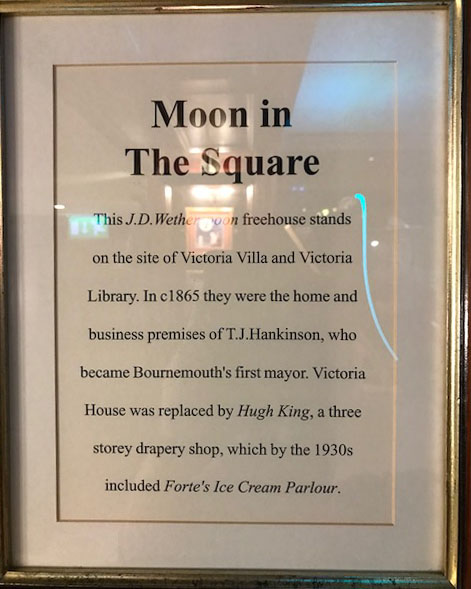
The text reads: This J D Wetherspoon freehouse stands on the site of Victoria Villa and Victoria Library. In c1865 they were the home and business premises of TJ Hankinson, who became Bournemouth’s first mayor. Victoria House was replaced by Hugh King, a three storey drapery shop, which by the 1930s included Forte’s Ice Cream Parlour.
Photographs and text about Tony Hancock.

The text reads: Tony Hancock is still regarded as one of the pioneers of British television comedy and at its peak, his Hancock’s Half Hour BBC TV show was a national institution – pubs emptied and shops shut early so people could get home to watch. His childhood spent in Bournemouth provided the inspiration for his famous comedy routines and persona, and he is still revered in the seaside resort.
The Hancock family moved to the town in 1927 when Tony was just three. After working in a laundrette and a pub, in 1933 his father John saw an exciting new opportunity for the family as they took over a hotel, renaming it Durlston Church Hotel. Tony’s first engagement was entertaining the troops at the Sacred Heart Church on Richmond Hill.
Text about the history of the area.

The text reads: The Moon in the Square – in which you are now standing – began life as Victoria Villa and the adjacent Victoria Library. The villa was home to Mr TJ Hankinson around 1865, and the library was his business premises. Originally he was a stationer and bookseller, later becoming an estate agent. In 1893 he became Bournemouth’s first mayor.
Victoria House was replaced by a three storey terrace building that housed Hugh King, a drapery store, around 1885.
In 1938 this site was occupied by Forte’s Ice Cream Parlour.
Originally The Square referred only to the area in front of the shops where Commercial Road and Exeter Road meet. These were the only shops in Bournemouth at one time. They occupy the former site of Decoy Pond Cottage. The rest of what is now The Square was known as The Bridge.
The first house in Bournemouth was The Mansion built by Lewis and Henrietta Tregonwell, which they occupied from 1812.
In 1820 they let The Mansion to Elizabeth Anne, the Marchioness of Exeter. She was the third wife of Henry Cecil, 10th Earl of Exeter and Marquess of Exeter.
It was this lady who lent her name to the building, and later to the road. Exeter House later became Newlyn’s Exeter Park Hotel, and is now Royal Exeter Hotel.
Illustrations and text about Mary Shelley.

The text reads: Mary Shelley, wife of the poet Percy Bysshe Shelley, creator of Frankenstein, and daughter of radical parents, is buried in Bournemouth at St Peter’s Church. She died aged 53, in 1851, 29 years after her husband had drowned in Italy, and 33 years after she had written the tale for which she is best remembered.
Born in 1797, her parents were the political and social radical William Godwin, and the feminist Mary Wollstonecraft. She was 17 when she eloped with Percy Bysshe Shelley, and later became his second wife. The couple spent their entire marriage abroad.
Frankenstein was written in 1818. After her husband’s death she returned to England with their son, and was granted an allowance by her father-in-law, Sir Timothy Shelley, whose estate was near Bournemouth, on the condition that she did not publish his son’s unpublished poems, which Mary had edited. She continued to publish her own stories and poems, and several works were published after her death.
Top: Mary Shelley in 1840
Left: The frontispiece of the 1831 edition of Frankenstein
Above: Percy Bysshe Shelley.
Photographs and text about East Cliff Railway.
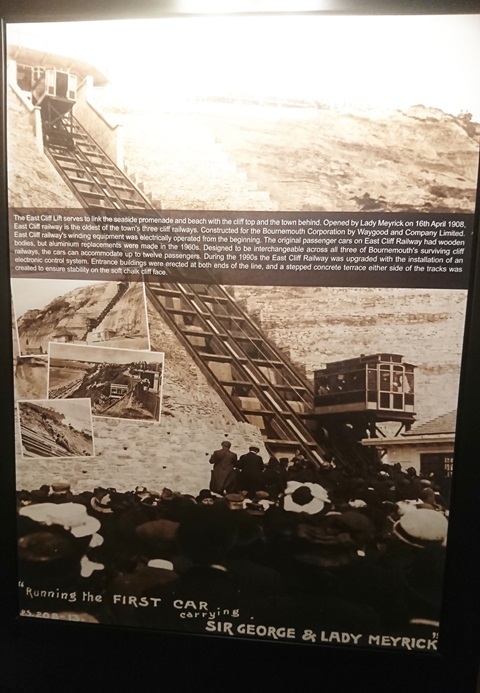
The text reads: The East Cliff lift serves to link the seaside promenade and beach with the cliff top and the town behind. Opened by Lady Meyrick on 16 April 1908, East Cliff Railway is the oldest of the town’s three cliff railways. Constructed for the Bournemouth Corporation by Waygood and Company Limited. East Cliff Railway’s winding equipment was electrically operated from the beginning. The original passenger cars had wooden bodies, but aluminium replacements were made up in the 1960s. Designed to be interchangeable across all three of Bournemouth’s surviving cliff railways, the cars can accommodate up to twelve passengers. During the 1990s the East Cliff Railway was upgraded with the installation of an electric control system. Entrance buildings were erected at both ends of the line, and a stepped concrete terrace either side of the tracks was created to ensure stability of the soft chalk cliff face.
Photographs and text about Bournemouth’s piers.
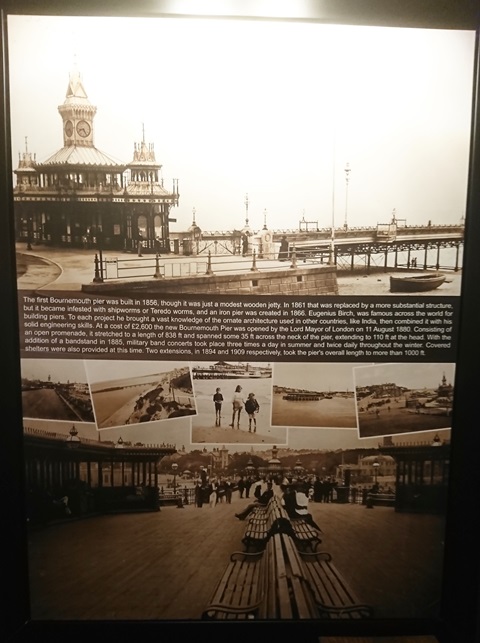
The text reads: The first Bournemouth pier was built in 1856, though it was just a modest wooden jetty. In 1861 that was replaced by a more substantial structure, but it became infested with shipworms or teredo worms, and an iron pier was created in 1866. Eugenius Birch was famous across the world for building piers. To each project he bought a vast knowledge of the ornate architecture used in other countries, like India, then combined it with his solid engineering skills. At a cost of £2,600 the new Bournemouth pier was opened by the Lord Mayor of London on 11 August 1880. Consisting of an open promenade, it stretched to a length of 838ft and spanned some 35ft across the neck of the pier, extending 110ft at the head. With the addition of a bandstand in 1885, military band concerts took place three times a day in summer and twice daily throughout the winter. Covered shelters were also provided at this time. Two extensions, in 1894 and 1909 respectively, took the pier’s overall length to more than 1000ft.
Text about the Honourable Charles Stewart Rolls.

The text reads: In 1910 Bournemouth celebrated its centenary (dating from the time that Lewis Tregonwell brought his wife Henrietta from Mudeford to see the great bay). Previously only hunters and smugglers frequented the bay before they built their home in 1812.
Part of the centenary celebrations involved the first international aviation meeting. One of the contestants in the various heats of aviation skill was the Honourable Charles S Rolls, co-founder of Rolls-Royce. He piloted a Short-Wright biplane, and attempted a pinpoint landing on a marked spot.
Suddenly as he came into land, something snapped. Parts of the tail plane broke off, and the machine plummeted to the ground.
Rolls did not survive. He crashed on the playing field of St Peter’s School, Southbourne. A plaque marks the spot with the words: “This stone commemorates the Hon. Charles Stewart Rolls who was killed in a flying accident near this spot on 12 July 1910, the first Briton to die in a powered flight”.
Rolls Drive, nearby, is named after him.
An illustration and text about the 108 Wright Biplane, 1907-8.
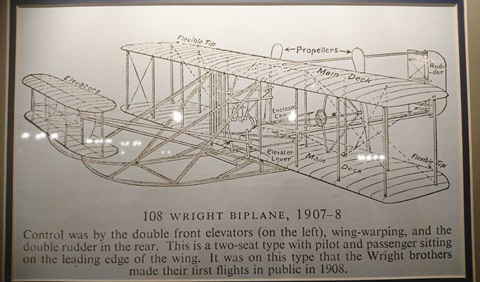
The text reads: Control was by the double front elevators (on the left), wing-warping, and the double rudder in the rear. This is a two seat type with pilot and passenger sitting on the leading edge of the wing. It was on this type that the Wright brothers made their first flights in public in 1908.
External photograph of the building – main entrance.
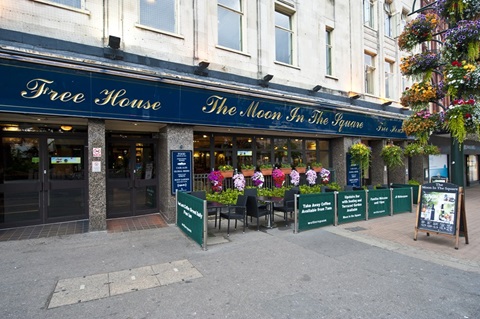
If you have information on the history of this pub, then we’d like you to share it with us. Please e-mail all information to: pubhistories@jdwetherspoon.co.uk